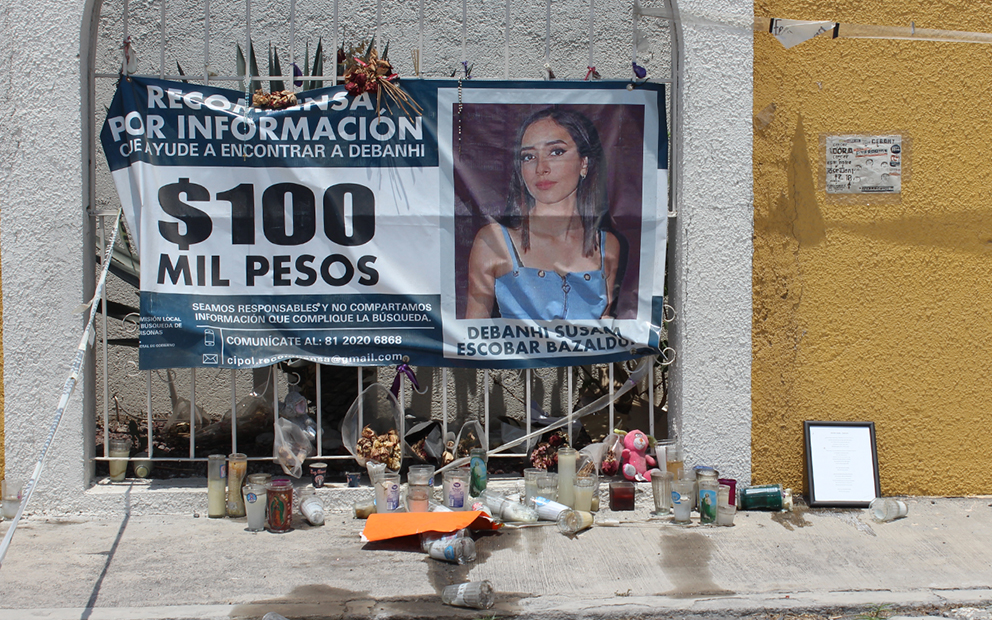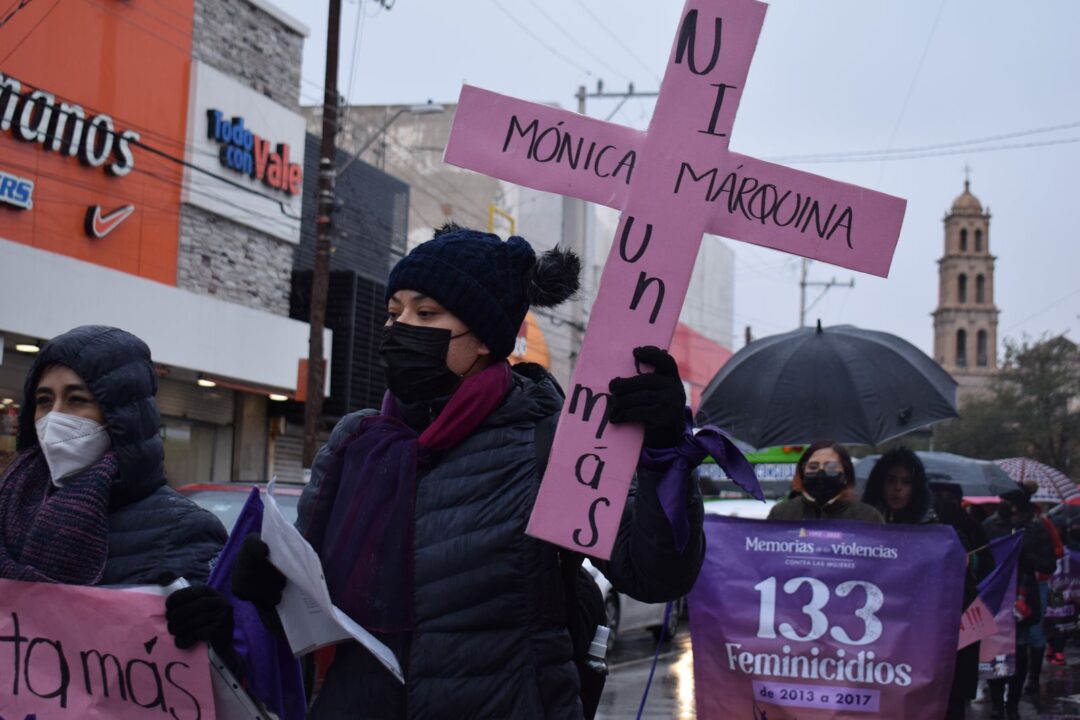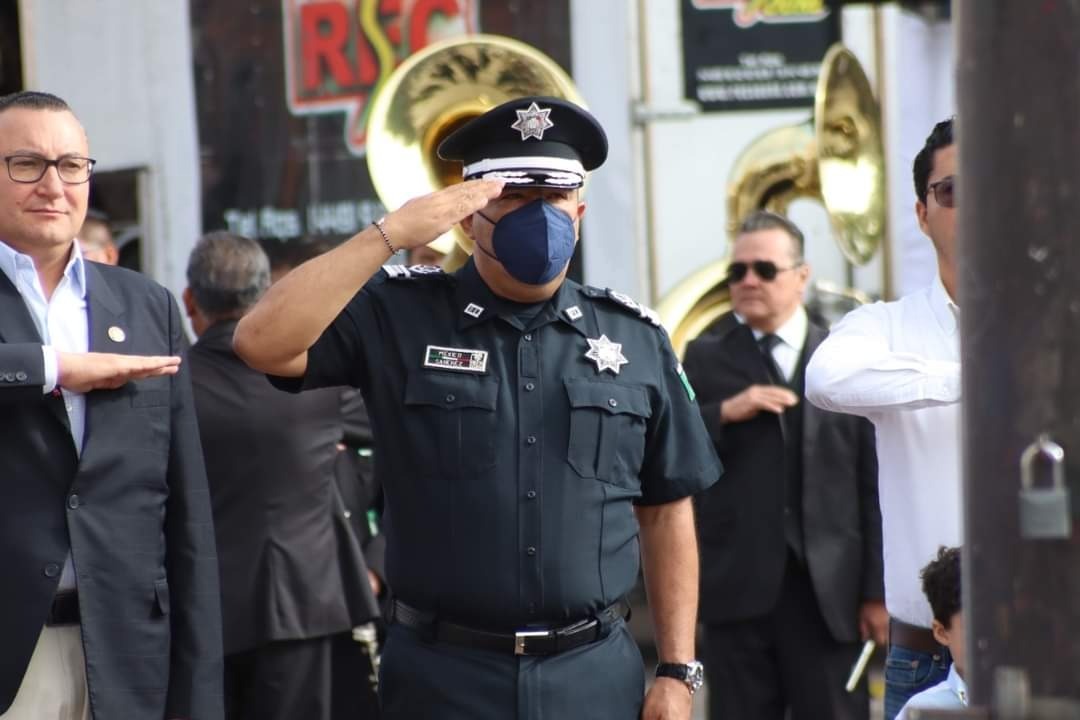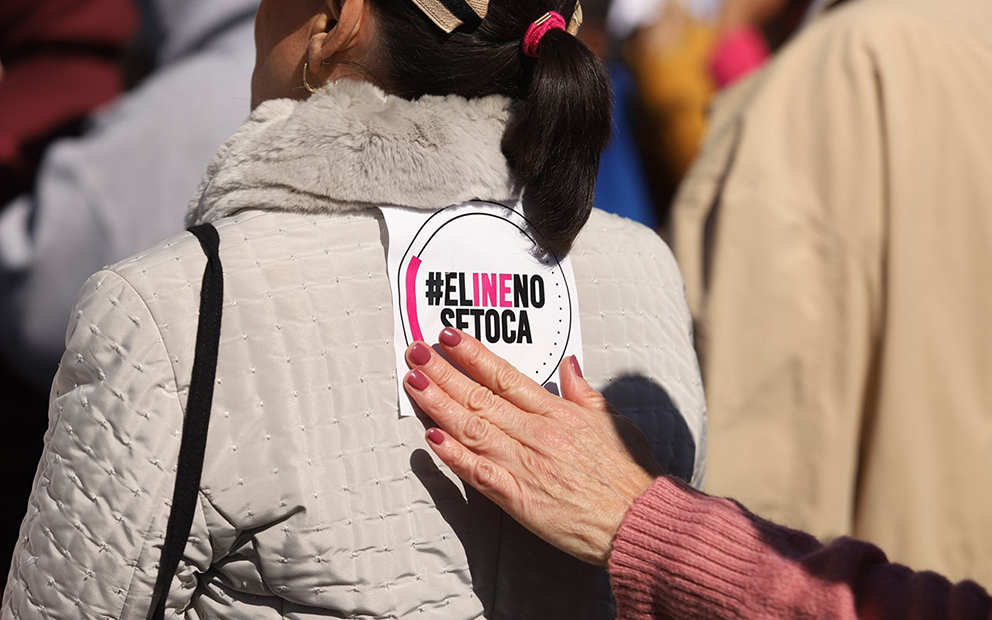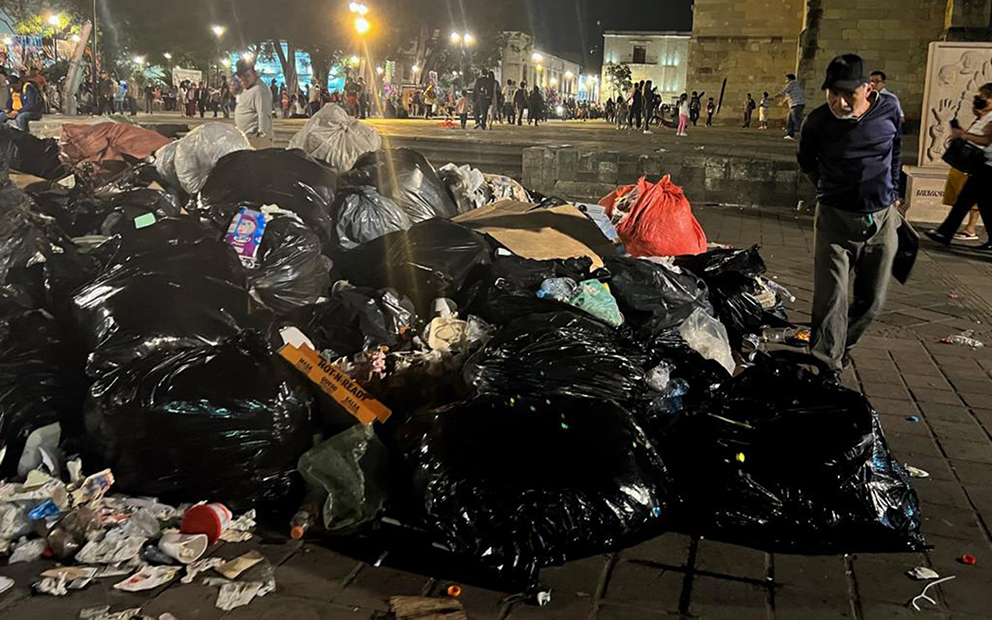Disappearances and femicides in the state of Nuevo León are above the national average, in a country that marked 100,000 disappeared in May. Authorities justify the numbers by saying it’s due to an effective and wide ranging count. But feminist collectives and other civil society groups say the numbers reflect a social and political phenomenon that’s much more profound and complex.
Text by Ignacio Alvarado Álvarez, originally published June 11, 2022.
Photos by Cuartoscuro and Obed Campos.
Translation by Dawn Marie Paley for Pie de Página in English.
MONTERREY, NUEVO LEÓN—The night that Debanhi Susana Escobar Bazaldúa’s body was found, the whole country was waiting for the news. The 18 year old had been disappeared for 12 days, after having attended a private party in a rented garden near the Nueva Castilla hotel, where her body was found in the water tanks on April 21. Before her death, the disappearance of hundreds of women—most of them minors—had moved the statistics registered in Nuevo León to above the national average, and revealed an issue feminists and academics had warned about four years earlier. Their warnings fell on deaf ears.
Another critical statistic, that of femicides in the Metropolitain Area of Monterrey, where 95 per cent of the population of Nuevo León lives, was being ignored. The line of cases began to rise in 2015, and hit a high in 2018, the year that it almost matched the number of men murdered. Since then, it’s risen much higher. During half a century, women lived largely without being directly impacted by crime. That reality changed with the militarization of public security in 2010, at the height of the supposed war on organizations dedicated to drug trafficking in the region.
“We forgot what it meant to get armed, to respond with weapons, to what was seen as the issue: narcotrafficking and organized crime,” said Séverine Durin, a professor at the Center for Research and Advanced Studies of Social Anthropology (CIESAS) in Monterrey.
Durin, who has been tracking the causes of violence in Nuevo León for the last 20 years, has no doubts about her findings.
“We’re faced with a practice that has become commonplace. It’s a practice that allows for impunity, so the perpetrators are transformed, as are those who are victims of disapperance… The form of violence against women changed. Which is to say, with the militarized strategy, México became a country of weapons. We’ve got a country that is heavily armed, and that has specific consequences. It’s very different when [she says, giving an example] there was violence against women in their intimate life, and there was yelling, and pushing, but not a conflict with guns [as takes place now].”
The strategy of fighting narcotrafficking declared at the end of 2006 by then President Felipe Calderón Hinojosa reached Nuevo León three years later. By then, there was a single statistic that followed the states that came first: the extraordinary number of homicides, disappearances and torture, of men and women. Between 2010 and 2011, Nuevo León surpassed 2,500 homicides for the first time. These numbers fell gradually as soldiers and marines left the state, though they remained well above previous years. The damage done socially is as deep as it is silent. Or it was until now.
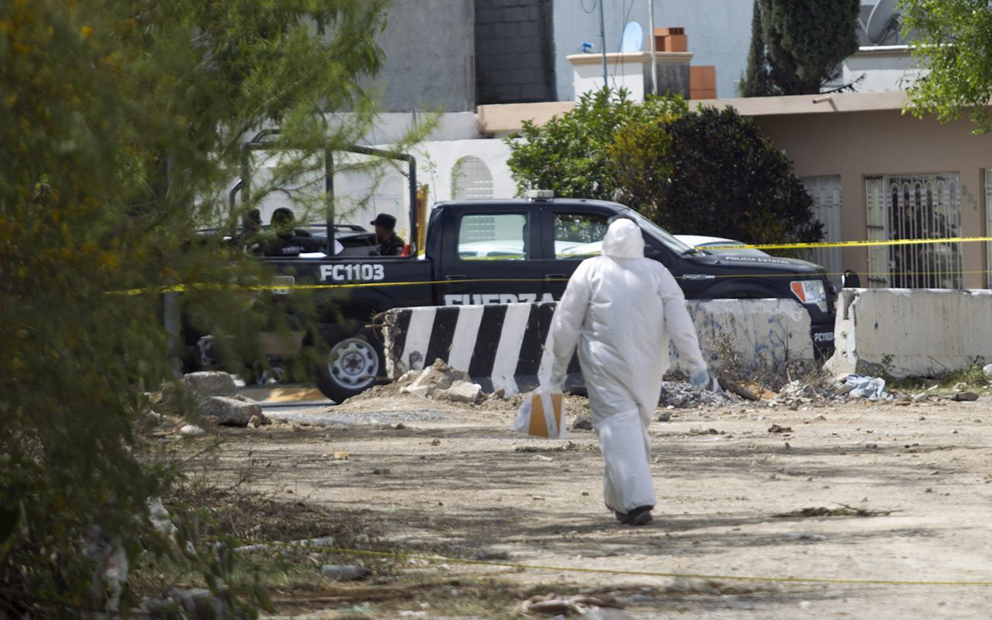
The Nueva Castilla hotel sits on the side of the highway that connects Monterrey with Nuevo Laredo, in the municipality of Escobedo. Within a distance of four kilometers from the hotel are a military base, the headquarters of the Civil Force (a state police force), the National guard, and the Federal Attorney General’s Office. Alongside them are warehouses and parking lots used by commercial truckers, and quintas, houses with large gardens which have become increasingly popular as locations to hold private parties. Debanhi Escobar left one of those in the early hours of April 9th. Her death is still shrouded in mystery and doubt, not just because of the mark for institutional power it carries, but also because it happened in an area with a strong presence of criminal groups.
“There’s a mix of a fabric—I wouldn’t say fabric—, but it’s social, a very special fabric,” said Aldo Fasci, Nuevo León’s Secretary of Public Security. “This is the reality of how our cities were built, not just in México but in all of Latin America. Wealth lives beside the most extreme poverty, with just a street between them. Security infrastructure is built to try and balance… In this context, [the disappearance and death of Debanhi] took place, and we don’t know what happened.”
“We have a mix—I’m going to mention what the President has said—of conservatives and liberals, and there’s an evident clash. But there’s also liberals and conservatives who are hipocrits who mix as libertines, in drugs, in alcohol, in sex, where all kinds of relations are mixed with no divisions whatsoever.”
“There is polarization, but here the only thing that divides us is illegality. All the illegal trafficking, all the illegal sales, all the commerce of illegal things,” said Fasci. “We have to recognize that the selling of drugs happens because someone is buying. If there’s organ trafficking, it’s because someone is buying. If there is trafficking in minors, or sex trafficking, it’s because someone is buying those services.”
Regardless of those statements, the public servant has been criticized by feminist groups for insisting in the disappearances and femicides in the state, which he has insisted are not different from in the rest of the country.”
“Here, every case of violent death of a woman is investigated as a femicide,” said Fasci. “If other states don’t do so, it makes us look worse, but it’s not our problem… In addition to the fact that we’re in a bad position nationally, is how we think things should be dealt with. All this adds up, how we treat the registries, it changes the perception. Here, anyone who is missing, lost, is considered disappeared because it activates the alerts. So our numbers appear monstrous.”
The art of make believe
In March of 2019, Jaime Rodríguez Calderón, known as El Bronco, announced the government had acquired a drone that cost 54 million pesos (US$2.6 million) and came with equipment that allowed for the location and interception of criminal elements without detection. It was handed over to the Fuerza Civil, the state security forces. Rodríguez, who today is in prison for alleged misuse of public funds, bragged about the drone as yet another tool that would help decrease criminal activity. In addition, the ex-governor had increased the number of security cameras in the state, from 560 to 835. In theory, Monterrey’s metropolitan area, with a population of nearly six million residents, was one of the most surveilled places in the country.
The Bronco’s tactical team added 4,000 cameras in the municipality of Monterrey. But the homicides increased, with more than 3,350 since. The number of disappearances of children, teenagers and women, most of them under 24, also increased. A 2020 evaluation carried out by the Fund to Support Public Security found that only 306 of the 835 security cameras operated by the state were functional. A few days after taking office as the new mayor of Monterrey, Luis Donaldo Colosio said half of the 4,000 cameras acquired by his predecessor didn’t work.
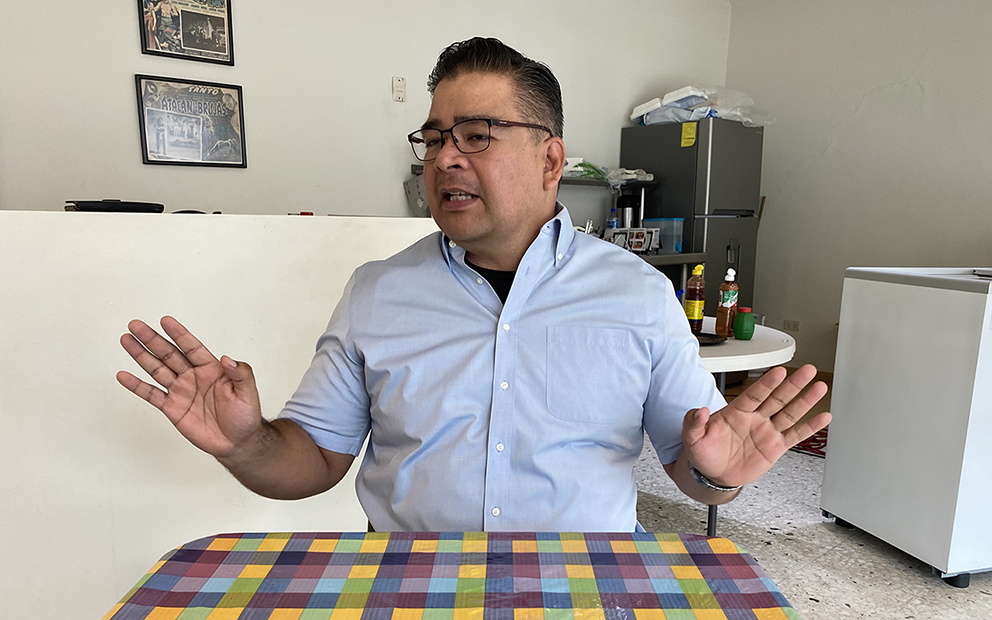
“Every day in Nuevo León people are murdered. There’s a way it’s done: people arrive in a car, break down a door, kill one or two people, escape, and that’s it. These aren’t fights between neighbors or disagreements. These are direct attacks” said Enrique Barrios, former local congressperson and Secretary of Transit and Roadways of Monterrey, a position he held a decade earlier, which led to his kidnapping by a criminal cell.
“It’s true that there’s not as many bodies being hung from bridges. It’s true that there aren’t dismembered bodies being left out in public, and that streets are no longer blocked by burned up vehicles. But what is completely true today is that every day, three or four people are murdered. We have peace, without shootouts, but not without violence. The state is full of drugs and guns. We all know it but we’ve decided to look the other way in the name of keeping up an image. That’s the context in which hundreds of young women and young girls have been disappeared and killed.”
The installation of the security cameras matches with the particularities of the peace described by Barrios. Since then, the halcones, people openly paid by organized crime to watch over certain areas in the municipalities of greater Monterrey, stopped appearing. But armed robberies, homicides and femicides and disappearances of women and children have carried on at an unstoppable pace, and not a single one has been captured using video surveillance tools. Unless the authorities are hiding evidence.
“It’s as if nothing was happening. That’s why we’re considering going and [demonstrating] in different municipalities as well,” said Claudia Muñiz, a members of the Feminist Assembly and United Forces for our Disappeared (FUNDENL), which was founded at the height of the federal anti-crime strategy in 2011.
“For example, the mayor of Escobedo [Andrés Mijes Llovera], made a declaration that is so shameful. He talked about how ‘we’re going to look after women, this won’t happen again.’ No repetition is a good thing, but we have to talk about what actually happened: What are your police doing?”
Streams of terror
Sabinas Hidalgo is the last important town to the north of highway 85, the federal road that connects Monterrey to Nuevo Laredo. It’s a town of 35,000, with single story houses, where the people live from ranching and farming watermelon and some grains. In the extreme southwest is La Turbina park, designed to attract regional tourism, something that has yet to occur. On this road, more than 300 people have disappeared in less than a year. Between August and October of 2021, a string of 11 women were disappeared, transforming the municipality into one of the black holes that has opened up in Nuevo León.
The Feminist Assembly, in which Muñiz is active, went to work immediately with regards to the 11 disappeared women from Sabinas. The profile of the victims makes it clear that it wasn’t a coincidence, rather a series of interrelated criminal acts. The women were between 18 and 23, most of them friends or acquaintances. Some of their bodies were found in December and January along highway 85. The rest are still being searched for.
“In March of 2021 there was a terrible escalation of disappearances on this highway, more than 300. They were men, women, and entire families,” said Muñiz. “The families sent us information about their cases and we published it on social networks. We started to speak out about what what happening but it kept getting worse until the month of August, and then came the cases of these women.”
They decided to hold a demonstration in front of the state attorney general’s office. The idea, according to Muñiz, was to attract attention from the mass media, because the distance to the town of Salinas meant the issue was outside the public eye.
“There was no interest from the Special Prosecutor for Disappeared People,” she said. “If they are doing any follow up, it’s because we’re keeping the pressure on.”
“There’s been a problem for many years with regards to the disappearance of people. But last year the disappearances of women began to increase, by 2022 there were even more cases, the first of which was that of María Fernanda Contreras. The case made waves in the media, and then came the case of Debanhi Escobar, which blew up. We think that that’s when the AG’s office decided to act like it is working and pretended to investigate. And at the end of the day, it’s obvious what the result was.”
In 2011, when FUNDENL was founded, most of the victims of disappearance were men, among them were police officers. Only two of every 10 reports of disappearance were women. FUNDENL was founded on the model of FUNDEC, a collective formed in December, 2009, in Saltillo, Coahuila, 86 kilometers west of Monterrey.
What was extremely disproportionate were the tables comparing the homicides of men and women. In June of 2021, the fact checking website Verificado created a graphic with data from the National Institute for Statistics and Geography, the UN Office on Drugs and Crime and the State Attorney General in Nuevo León. Until 2016, the breach between feminicide and the killing of men was huge. It began to close between 2018 and 2019, when it became nearly equal.
Séverine Durin, the CIESAS researcher, doesn’t have an exact explanation of what made these statistics jump at the same time as the disappearances of children, teenagers and young women, the terrible stream that opened in Nuevo León. What’s clear is that it isn’t part of a meticulous registry of violence, as the Secretary of Security has suggested.
“Something happened, and I can only share a hypothesis,” said Durin. “The Specialized Group for Immediate Searches was created, and we have to understand who is in charge of searching and investigation, and who is part of the AG’s office. Inside the AG is the State Investigations Agency, which includes the Ministerial Police, and inside that group is another specialized group made up of the Public Ministerial Police, that has a police commander at its head. It’s those groups that are in charge of the investigations, and of knowing what is happening with regards to disappeared people from the outset.
Durin describes a monopoly which by 2018 includes the Local Search Commission whose formation, against all logic, coincides with the increase in disappearances.
A year ago, the researcher published one of various academic texts that analyze the crisis, titled “The disappearance of girls and teenages in Nuevo León are based on sex and trafficking with intent of sexual exploitation as a principle motivation.” In it, the researcher shares numbers which should have been cause for concern from authorities. For example, the growing disappearances of minors between 10 and 17 years old and the 80 percent increase in investigations into potential human trafficking. All at the same time, over the decade, beginning in 2012, Nuevo León has registered 6,000 disappearances, 1,700 of them of women. Since then only three sentences have been made for that crime, two of which were absolved. Total impunity.
From 2018 to 2022, the number of disappearances at a national level has remained steady. It’s not that there’s less crimes committed, but that the percentage is stable. What’s notable is that in Nuevo León, the number of women as a percentage of the official count rose significantly. First in the major registry, which goes from 2000 to 2022 (23.90 nationally and 28.72 in Nuevo León), and then in the more recent registry, from 2018 to 2022 (24.87 nationally and 35.6 in Nuevo León). The statistics were compiled by Durin using data from the National Registry of Disappeared and Missing People.
A highly armed society with patterns of widespread impunity creates an excellent starting point from which to understand what is taking place. But the researcher from CIESAS focussed her most recent work on an even more terrifying phenomenon: impacts on minors. Her book, which is currently being printed, is called Amputated Childhoods, Adolescents at Risk: Militarization and Violence in Northeast México.
The numbers she shares there show, for example, that Monterrey is the state with the highest proportion of cases of disappeared children and adolescents, at three for every 10,000 residents. That’s double the amount in the rest of the metropolitan area.
Durin focuses her analysis on the cracks in the system on a general level. Nuevo León is a carbon copy of what is taking place in the rest of México, where the three branches of the state are failing. There’s no investigations, there’s no sentences, and there’s no calls for accountability from the state congress, which is dominated by the Institutional Revolutionary Party (PRI) and the National Action Party (PAN). In one of the graphics in Durin’s book, there is a comparison between cases of children disappeared in Coahuila, Nuevo León and Tamaulipas. Between 2015 and 2017, there are some similarities, but beginning in 2018, Nuevo León blows up to 80 percent more such crimes than in neighboring states.
“How was the militarization of public security undertaken? Why? Well, it was done in a complicated post-electoral context, and the United States interfered in the process of implementation. The objective itself wasn’t bad: the fight against organized crime. The problem is how they decided to proceed,” said Durin. “There’s an enormous problem. There’s no push for justice. There’s no push to undo organized crime in México. What is organized crime? It’s something that depends on the participation of public servants, and there’s no policies in México designed to fight against organized crime.”
The first lady and the governor
In the morning of the same day the body of Debanhi Escobar was found, a group of feminists and womens’ rights activists held a meeting with governor Samuel García, his wife Mariana Rodríguez, and part of the state’s cabinet. They gave a list of demands to the governor, which included an end to repression of their events, following police violence during a march on April 10. García and his wife had just left a two hour long meeting with Debanhi Escobar’s parents. The governor seemed annoyed.
“It was very, very uncomfortable. You could see it on his face, like, ‘I don’t want to be here.’ He was very rude at the start of the meeting,” said Paola González, of the ¡Ya Basta Nuevo León! Collective. But his attitude became less important once his wife began speaking.
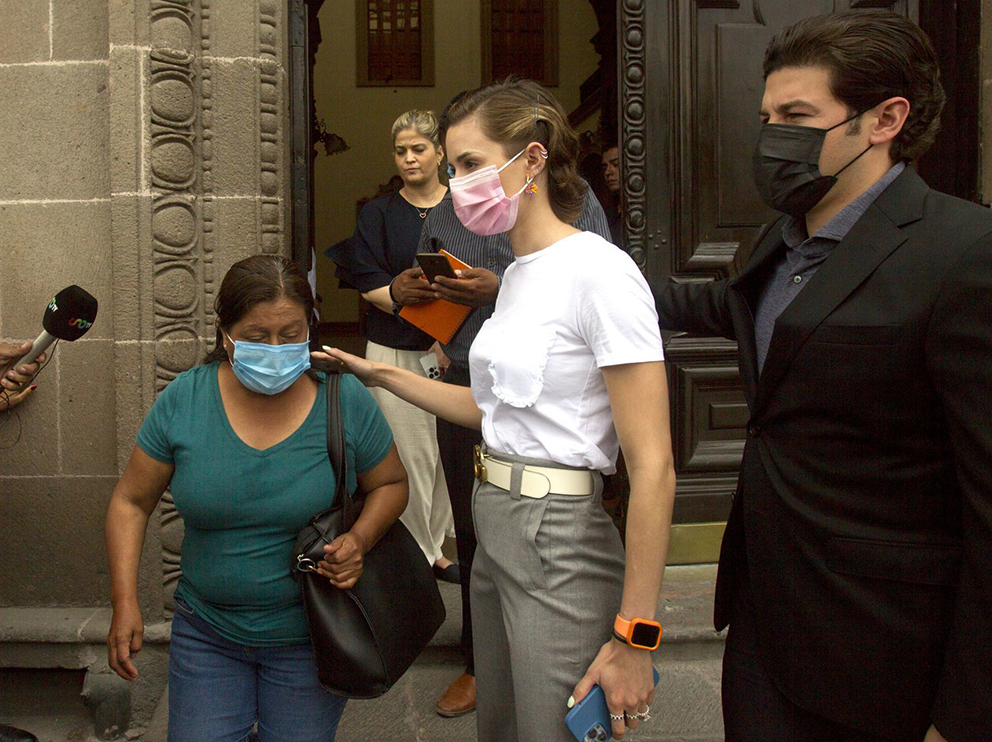
“Mariana starts talking, and she says: ‘I need to be moved. I need, I mean, I want to join your struggle but I need to be moved, you need to move me. I can join… I mean, if you call on me, I’m there, but you’re not moving me. And also, you’re always, I mean, you are always attacking me and I am, I mean, I want to be with you, but I need you to move me.’ It was super brutal for those of us who were there, because we knew they had just been with Debanhi’s parents. That didn’t move her?”
For González, that scene summarizes the lack of empathy and comprehension of what is taking place, not just on the part of Rodríguez, but on the part of the governor and his cabinet. They promote the idea that, for one, the profound social crisis should be minimized in favor of an institutional narrative that either cannot be sustained by facts, or revictimizes and disqualifies the evidence, compiled using official numbers, brought forward by civil society associations and feminist collectives.
“It’s a narrative that can’t be justified, that isn’t valid any longer,” said Ivonne Bustos, the executive secretary of Nuevo Leon’s Women’s Institute.
“We’ve seen how the issue of disappearances has grown, and how it’s related to human trafficking networks and organ trafficking,” said Bustos. “But instead of investigating that, we just keep talking about how it’s done, or how the practice is established, without seeing what is happening as part of a terrible phenomenon. What people have told us, based on everything that’s happening, points to an alarming increase in disappearances.”
Bustos, who is an internationalist specialized in women’s legal rights and urban development, is another inconvenient bureaucrat, participating in a government that has feigned interest in cases of femicide and disappearance. In our interview, Bustos mentioned the possibility of her resignation from the state’s Women’s Institute in the face of what she considers an institutional farce. Previously, Alicia Leal, founder of Peaceful Alternatives, a civil society group that attends to women who have survived rape, resigned from the Women’s Secretariat for similar reasons.

“We’ve got cases like Sabinas Hidalgo, where 10 women were disappeared at once. And what happened? Nothing. There, the justification [on the part of authorities] was that they must have been involved in criminal activity,” said Bustos. She added:
“In the metropolitan area, things aren’t different. We’ve seen all these disappearances every month, every year, and the years pass, the months, and the days, and nothing happens. The government just seems to see it all from a different perspective, and they don’t empathize with the victims’ families. Until we arrive at a commonality there, we’re going to see this problem continue to get worse.”
At the root of this discrepancy, according to Bárbara González of Mujeres+Mujeres, is frivolity. “For the government this is an image problem, that’s why they automatically respond by saying ‘here we count properly.’ They are invested in this crisis being unknown, in it not being talked about. How and who decides that this is an important issue? In what moment does this transcend and go beyond those levels? It wasn’t until the cases of María Fernanda [Contreras] and Debanhi [Escobar] that this became an important issue in Nuevo León. That’s why it’s important to see who and what are the forces at work to keep this as something that isn’t relevant. And to understand why.”
The Gansito theory
On the last day of March, a father waited near the highschool where his daughter studied in Juárez, a municipality of metropolitan Monterrey. He waited for her there every school day, around 300 meters away, at a bus stop, so she wouldn’t be embarrassed. That day, she never arrived. The AG’s office registered her disappearance at 1:30pm, and opened three lines of investigation in three neighborhoods. None of them convinced the minor’s parents. The teen’s entire family searched for her in places the authorities wouldn’t. They found her walking the streets a month and a half later, in mid-May. She was in a daze, still wearing her school uniform, which was filthy. She was in a state of total shock.
The area where the minor was found is the same in which, on May 9th, the body of Yolanda Martínez was discovered. The 26 year old disappeared on March 31st. That morning, she had gone to visit her grandmother, who lives in the municipality of San Nicolás de los Garza. Her last known whereabouts were at the same bus stop near the highschool, around 1pm. Yolanda’s body was already decomposing when it was found. Beside it was a styrofoam cup, in pristine condition regardless of the rains, the overgrowth and the garbage in the vacant lot. Investigators say she wrote the message on the cup before taking her own life.
Yolanda’s killing offers a portrait of a criminal era. At least that’s what Claudia Muñiz, of the Feminist Assembly and FUDENL says. For her and the rest of her compañeras, the intention of the state was to manipulate public opinion by sharing, as in the case of Debanhi, the results of a dubious necropsy framed by a stigmatizing narrative. That’s why they’ve asked for a second necropsy, this time done independently.
“For years there’s been pressure for authorities to incinerate the remains of men and women who are found dead,” asid Muñiz.
“That happened with our compañera Brenda Damaris. They gave her the partial remains of her daughter in a garbage bag and they asked to cremate them. Thankfully she asked the group and we said no. A year later [in 2012], the remains were exhumed to confirm that they did in fact belong to Brenda [Brenda and her daughter shared the same name]. The authorities have no credibility, but the families don’t need to go through all of that anymore. Now they know that there are other ways to do searches and identification.”
Weapons, corruption and hypocrisy ensnare the principle of justice that the victims demand. But in the depths of the system, and of society, it’s possible to find something that brings clarity or helps the understanding of one of the key elements that animates criminality and violence. At least that’s what Aldo Fasci, the Secretary of Public Security, thinks. He uses common crime as an example.
“Take theft from a shop. Someone comes in and takes some gansitos [a single serving, chocolate covered sponge cake]. If we don’t pay attention to the thief who steals the gansitos, they’ll come back and steal a box. Then they’ll steal a box with money. And then they’ll come with a gun, because we didn’t stop them on time. But detaining the thief for the gansitos isn’t about putting him in jail, it’s about changing their conditions,” said Fasci. “And there’s impunity there, with the gansitos. It exists because we didn’t detain him, but detanining him doesn’t necessarily mean jail. The Constitution and the accusatory [justice] system prevents jail for everyone. Jail is the last resort. Temporary detention can be used in those cases, and it depends on the individual. Now, México’s jails are verging on explosion. So what happens? That’s perception. Remember that perception is reality, in the mix between numbers, unresolved cases, resolved cases, it seems like there’s no justice. We’ve got a very toxic mix, very damaging, because people are stuck with the idea that ‘there was no justice.’”
But beyond theories of criminal motivation, there is an absence of prevention, investigation and solving crimes, said Enrique Barrios, the former head of Highways and Transportation who was kidnapped.
“How can someone go missing in a municipality? Because there’s no police. If a [young lady] is walking, and a car goes by and kidnaps her, they can leave the state and no one will stop them. [The authorities] talk and talk about security, protection, but it’s false. We’ve never seen a police officer detain a kidnapper or someone who has picked up [a young woman against her will]. They disappear, but nobody sees. This happens in a city of this size, with a powerful economy… The key word here is trickery.”
Click here to sign up for Pie de Página’s bi-weekly English newsletter.
Ayúdanos a sostener un periodismo ético y responsable, que sirva para construir mejores sociedades. Patrocina una historia y forma parte de nuestra comunidad.
Dona

